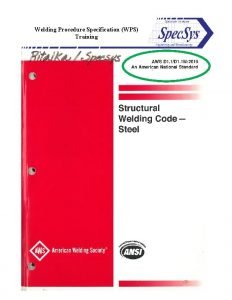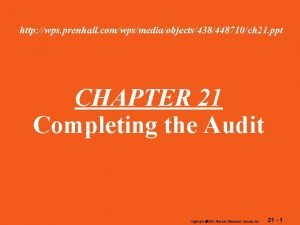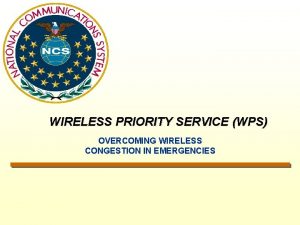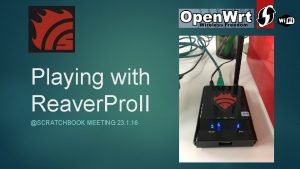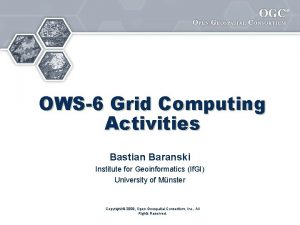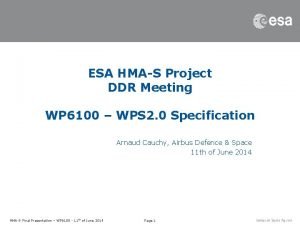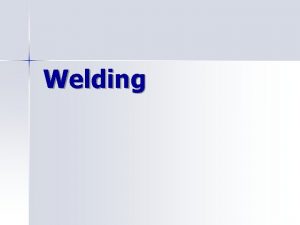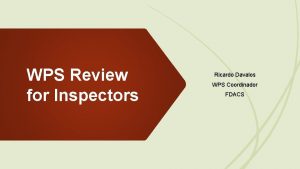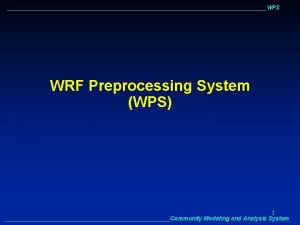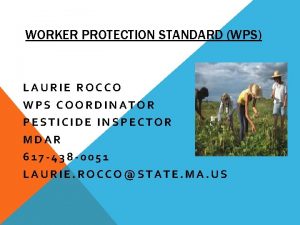Welding Procedure Specification WPS Training Welding Procedure Specification






- Slides: 6

Welding Procedure Specification (WPS) Training

Welding Procedure Specification (WPS) Training 8 1 9 2 3 4 10 11 5 12 6 13 7 14 15 16 A B C D E F G H 1

Welding Procedure Specification (WPS) Training 1 Each WPS is assigned a unique control number beginning with acronym or letters associated to one of the welding processes below: GMAW – Gas Metal Arc Welding, i. e. Hard Wires and Metal Coded Wires. FCAW – Flux Core Arc Welding SMAW – Shielded Metal Arc Welding, i. e. Stick Electrodes 2 Joint Design used gives a brief description of the weld joint the WPS is qualified for use. Deviation from the joint configuration does require requalification of the WPS. 3 Backing Material specifies the backing material Group Number or specific type of steel that the WPS is qualified to. When a Backing Material is specified, a backer MUST be used. A weld joint CAN NOT be welded without a backer. 4 Back Gouging will be specified to be performed and the method required. Note: CJP (Complete Joint Penetration), when specified on the print in the Tail Section of the weld symbol, can only be achieved by either using a Backing Material or Back Gouging. 5 6 Base Metals / Material Specified maybe defined as a specific type and grade of material, i. e. ASTM A 588, Gr 50 or by Group I and/or Group II Steels. Group I, III and IV steels are found in the AWS Code Book. The thickness of the base material will be specified typically in a range of thicknesses, i. e. ¼” – Unlimited. Filler Metal is the welding wire or electrode specified to be used under this WPS. The AWS Specification Number and Classification Number are found on the outside of the box and on each spool of wire. Never use a welding electrode that is not properly identified. Welding Position identifies the position the welder MUST be welding in. 2

Welding Procedure Specification (WPS) Training 7 Welding Position identifies the position the welder MUST be welding in. 8 Welding Unit is define as: Manual – SMAW (Stick) Machines Semi – Automatic – GMAW, FCAW (Wire) Machines Automatic – Robotic Machines 9 Electrical Characteristics specifies the polarity required, i. e. DCEP (Direct Current Electrode Positive). 10 Shielding is the gas composition specified, i. e. 90% Argon / 10% Co 2 or C 10 11 Technique of welding will be specified as Single Stringer Beads or Weave Bead. 12 13 Preheat maybe required depending the type, grade or thickness of steel being welded. Interpass Temperatures is the temperature of the steel between each weld pass. When specified the temperature must be monitored. Cleaning requirements: Initial Cleaning: Wire Brush / Grinder is the most traditional method of cleaning a weld joint prior to welding being performed. There maybe occasions where chemical cleaning maybe required, i. e. degreasing solvent to remove contaminates from machining process or sandblast to remove heavy scale. Interpass Cleaning: Wire Brush / Needle Peener / Grinder are the most standard methods used to clean between each weld pass to remove flux or slag. 3

Welding Procedure Specification (WPS) Training 14 Groove Preparation: Because this WPS happens to be a PREQUALIFIED welding procedure, AWS has specific requirements that need to be maintained when comes to joint detail, set-up, and/or design. Any deviation, beyond the tolerances allowed, will require requalification of the WPS. 15 Joint Detail: Is a basic drawing of the joint detail specifying the Root Opening (1/4”), Groove Angle (45 Deg, +10 / -5 Deg), and the Weld Symbol (V-Groove with a Backing Strip). 16 Welding Procedure: A Pass or Weld Layer(s): “All” indicates that any and all passes of weld must be run according to the parameters noted. Note: There are times were it will be necessary for a weld joint to be welded using different Amps, Volts, and Travel Speed. When this is required, the Pass or Weld Layer(s) box(es) will be numbered “ 1”, “ 2”, “ 3”, etc. It is the Welders responsibility to conform to the requirements / parameters of each of the different Passes. B Process: Welding Process(es) GMAW – Gas Metal Arc Welding, i. e. Hard Wires and Metal Coded Wires. FCAW – Flux Core Arc Welding SMAW – Shielded Metal Arc Welding, i. e. Stick Electrodes GTAW – Gas Tungsten Arc Welding C Filler Metal: D Current: Class: AWS Classification discussed in Section 6. Dia. : Is the diameter or size of the welding electrode required. E Type & Polarity: DCEP discussed in Section 9. F Amps or Wire Feed Speed: Welding machines MUST be set within the specified Amps and/or Wire Feed Speed (WFS). Failure to do so may result in product rework. 4

Welding Procedure Specification (WPS) Training G Volts: Welding machines MUST be set within the specified Voltage range. Failure to do so may result in product rework. H Travel Speed: Is the rate of speed of the electrode moving across a plate. 5
